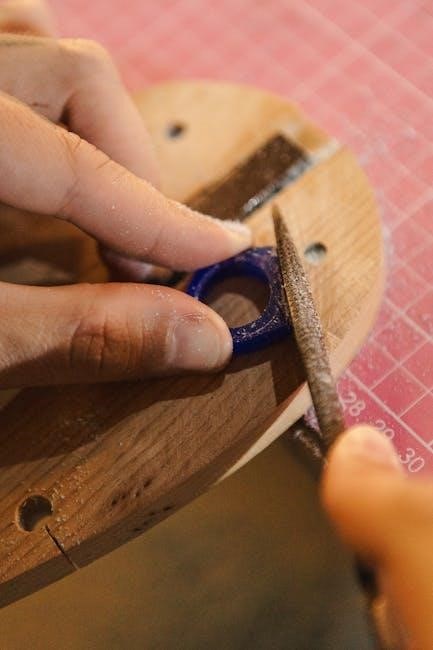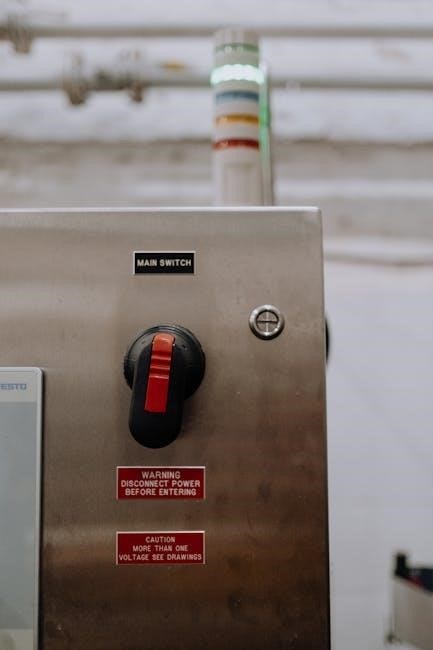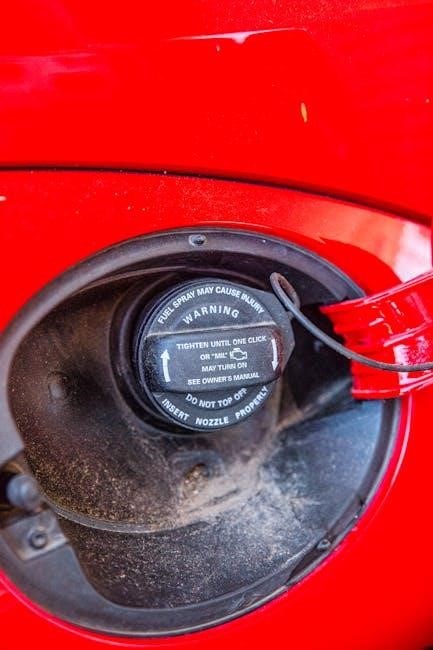A label maker is a portable device that uses thermal printing technology to create customizable labels for organization and efficiency․ Ideal for offices, homes, or classrooms, these tools simplify tasks like labeling files, cables, and storage containers․ With built-in keyboards, Bluetooth connectivity, and adjustable settings, label makers offer a user-friendly solution for creating clear, professional labels․ They are versatile, time-saving, and essential for enhancing productivity and organization in various settings․
What Is a Label Maker?
A label maker is a portable electronic device designed to create customizable labels for various purposes․ It uses thermal printing technology to produce clear, durable text on adhesive tapes․ These devices often feature keyboards for typing, adjustable settings for font sizes and styles, and compatibility with different tape widths․ Label makers are commonly used in offices, homes, and classrooms to organize files, cables, and storage containers․ They offer a convenient way to create professional-looking labels, making them an essential tool for enhancing productivity and efficiency in both personal and professional environments․

Why Use a Label Maker?
A label maker is an essential tool for enhancing organization, efficiency, and clarity in various settings․ It helps create professional-looking labels for files, cables, storage containers, and more, saving time and reducing clutter․ With a label maker, you can easily identify items, improving accessibility and productivity․ Its portability and ease of use make it ideal for offices, homes, classrooms, and event planning․ Additionally, label makers support creativity, allowing you to design custom stickers, gift tags, and personalized labels․ By streamlining labeling tasks, they help maintain a tidy and organized environment, making them a valuable investment for both personal and professional use․
Popular Types of Label Makers
Label makers come in various types to suit different needs․ Manual label makers are simple, portable, and ideal for basic labeling tasks․ Thermal label makers use heat to print labels and are popular for their durability and clarity․ Bluetooth label makers offer wireless connectivity, allowing users to print labels from mobile devices․ PC-connected label makers are designed for high-volume use and offer advanced customization options․ Additionally, some label makers combine multiple features, such as built-in keyboards, adjustable font sizes, and symbol libraries, making them versatile tools for both personal and professional use․

Setting Up Your Label Maker
Unbox and insert batteries or connect power, then install the software․ Sync the label maker with your computer or mobile device for seamless operation and customization․
Unboxing and Initial Setup
Start by carefully unboxing your label maker, ensuring all components are included․ This typically includes the device, label tape, batteries, and a user manual․ Before first use, install the batteries or connect the power cable as specified․ Some models require alkaline batteries, while others may come with a rechargeable option․ Gently remove any protective packaging from the device and ensure the label tape is properly loaded․ Avoid pulling or applying pressure to the tape, as this could damage the cassette or printer․ Finally, familiarize yourself with the keyboard layout and basic controls before proceeding to software installation or first use․
Inserting Batteries or Connecting Power
Begin by inserting the required batteries or connecting the power cable․ Most label makers use high-capacity AA alkaline batteries, while others may have rechargeable options․ For battery-powered models, open the compartment, usually located on the back or bottom, and insert the batteries as indicated․ Ensure the polarity matches the diagram․ If using a power adapter, plug it into the device and a power outlet․ Some models, like the Brother P-touch series, require turning on the device after inserting batteries․ Always use the recommended battery type to avoid damage․ For rechargeable options, charge the device fully before first use․ Turn on the label maker to confirm power functionality․
Installing Label Maker Software
To install the label maker software, visit the manufacturer’s official website, such as DYMO or Brother, and download the correct software for your model․ Run the installer and follow the on-screen instructions to complete the installation․ Some models, like Brother label makers, require apps like PT Design Print or PTouchDirect․ Ensure your device is connected to your computer or mobile device after installation․ Refer to the user manual for specific instructions, as some models may require additional drivers or updates․ Proper installation ensures seamless functionality and access to advanced features․ Always use software from trusted sources to avoid compatibility issues․
Syncing with Computer or Mobile Device
To sync your label maker with a computer or mobile device, start by enabling Bluetooth on both devices․ For models like Brother label makers, download and install the PT Design Print app․ Ensure the label maker is turned on, with a green light indicating it’s ready to connect․ Follow in-app instructions to pair the devices․ For wired connections, use a USB cable to link the label maker to your computer․ Ensure the device is recognized by your operating system and the label maker software․ Some models, like DYMO devices, may require specific drivers or updates for seamless connectivity․ A stable connection is essential for printing labels wirelessly or via cable․

Basic Operations
Basic operations involve loading label tape, typing text, selecting fonts, and printing labels․ These steps ensure efficient and clear labeling for various tasks and projects․
Loading the Label Tape
Loading the label tape is a straightforward process that ensures your label maker is ready for use․ Start by cutting the label tape to the desired length or use a pre-cut roll․ Align the tape with the maker’s slot, ensuring it matches the device’s specified width․ Gently insert the tape into the machine until it clicks into place․ For thermal label makers, the tape should be loaded with the thermal side facing the print head․ Avoid touching the thermal side to prevent damage․ Once loaded, the device is ready to print labels․ Proper loading ensures clear, professional results․ Use compatible tape sizes, such as 12mm or 24mm, for optimal performance․
Typing and Editing Text
Typing and editing text on a label maker is designed to be intuitive․ Use the built-in keyboard to input your desired text, and navigate using arrow keys to move between characters․ Many models allow editing before printing, enabling you to delete or modify text using the backspace button․ For more complex designs, connect your label maker to a computer or mobile app, where you can type and edit labels with greater ease․ Ensure the text fits within the tape width by previewing it on the device or app․ This step ensures your labels are clear, professional, and accurately formatted before printing begins․
Selecting Font Styles and Sizes
Selecting font styles and sizes on a label maker enhances label clarity and aesthetics․ Use the arrow keys to navigate through available fonts, typically ranging from standard to bold or italic․ Choose from multiple size options to fit your label’s design․ Preview the text on the display to ensure proper formatting․ Some models allow switching between uppercase and lowercase letters․ For advanced customization, connect your label maker to a computer or app, enabling access to a wider range of fonts and sizes․ This feature ensures your labels are visually appealing and easy to read, meeting your specific organizational needs effectively․
Printing Your First Label
Printing your first label is straightforward once the label maker is set up․ Load the label tape, enter your desired text, and select font styles and sizes․ Use the preview screen to review your label before printing․ Press the print button to produce the label․ Ensure the tape is aligned correctly to avoid errors․ For precise cuts, use the automatic cutter if available․ Test the label on a surface to confirm adhesive strength․ If using iron-on labels, follow the manufacturer’s instructions for application․ This process ensures your labels are clear, professional, and ready for immediate use, making organization effortless and efficient;

Advanced Features
Advanced features enhance customization and efficiency, allowing users to add symbols, use various label sizes, adjust print settings, and enable automatic cutting for precise, professional results every time․
Customizing Labels with Symbols
Customizing labels with symbols enhances their visual appeal and functionality․ Many label makers, such as Brother P-Touch and DYMO models, offer built-in symbol libraries․ Users can access these symbols through the device’s menu or accompanying software․ This feature is ideal for adding icons, arrows, or logos to labels, making them more professional and engaging․ For example, users can add a warning symbol to cables or a decorative icon to gift tags․ Some devices even allow importing custom symbols or images, expanding creative possibilities․ This feature is particularly useful for organizing tasks, creating event badges, or designing custom stickers with a personal touch․
Using Different Label Sizes
Label makers support various label sizes, catering to different needs․ Common sizes include 12mm, 24mm, and 36mm widths, suitable for tasks like labeling cables or storage containers․ Users can switch tapes to match their project requirements․ For instance, narrower tapes are ideal for small items, while wider tapes are better for large containers or event badges․ Many devices automatically detect tape size, ensuring proper formatting․ Some models also offer adjustable settings to customize label length and layout․ This versatility allows users to create labels that fit perfectly, enhancing organization and readability in both personal and professional settings․
Adjusting Print Settings
Adjusting print settings on a label maker allows for customization to suit various needs․ Users can modify font size, style, and alignment to enhance readability․ Many devices offer bold or italic options, while some support multiple lines of text․ Print density can also be adjusted for clearer labels․ Advanced models enable margin and spacing adjustments, ensuring precise label formatting․ Some label makers include a preview feature to review labels before printing, reducing errors․ Adjusting these settings often involves using the device’s keyboard or companion software․ Properly configured print settings ensure labels are professional, legible, and tailored to their intended use, whether for files, cables, or storage containers․
Cutting Labels Automatically
Many label makers feature an automatic cutting function, which trims labels to the desired length after printing․ This saves time and eliminates the need for scissors․ Some models offer a partial cut option, leaving a small tab for easy removal, while others provide a full cut for standalone labels․ Advanced devices may include sensors that detect label length and adjust cuts accordingly․ Automatic cutting ensures consistent and precise label edges, reducing waste and improving efficiency․ For optimal results, ensure the tape is loaded correctly and the cutter is clean․ This feature is especially useful for high-volume labeling tasks, streamlining the process significantly․

Troubleshooting Common Issues
Resolve tape jams by turning off the label maker, removing the tape, and gently clearing obstructions․ Check connections for printing or power issues and ensure proper tape installation․
Resolving Tape Jam Issues
A tape jam can occur due to misaligned or damaged tapes․ To resolve this, turn off the label maker and carefully remove the tape cassette․ Gently pull the jammed tape out without forcing it, as this could damage the internal mechanism․ Ensure the tape is properly aligned when reinserting it․ Avoid pulling the tape from the cassette forcefully, as this can cause further jams․ Regularly cleaning the label maker and using high-quality tapes can help prevent such issues․ Always refer to your device’s manual for specific instructions, as procedures may vary between models; Proper care ensures smooth operation and longevity․
Fixing Connectivity Problems
Connectivity issues with label makers often arise from Bluetooth or Wi-Fi misconfigurations․ Ensure your device is turned on and properly paired with your computer or mobile device․ Restart both devices and check the app or software for connection options․ Verify that Bluetooth is enabled and your label maker is discoverable․ If using a wired connection, inspect the USB cable for damage․ Download the latest software updates for your label maker and ensure the app is installed correctly․ Consult the user manual for specific pairing instructions, as procedures may vary by model․ Proper connectivity ensures seamless label printing and efficient operation․
Addressing Low Battery Warnings
If your label maker displays a low battery warning, turn it off immediately to conserve remaining power․ Replace the batteries with new, high-capacity ones, ensuring they are installed correctly․ For rechargeable models, connect the device to a power source using the provided cable․ Allow it to charge fully before use․ If the issue persists, check for battery compartment damage or corrosion․ Clean contacts with a soft cloth if necessary․ Store unused batteries properly to avoid drain․ Regularly updating your label maker’s software can also improve battery performance and prevent low-power errors․ Always use compatible batteries for optimal functionality․
Solving Printing Errors
When encountering printing errors, first ensure the label tape is correctly loaded and free from damage․ Turn the device off, wait a few seconds, then restart it to reset the system․ Check for paper jams and gently remove any obstructing tape․ Verify that the correct tape size and type are selected in the settings․ If issues persist, clean the print head with a soft cloth and update the label maker’s software․ For persistent problems, refer to the user manual or contact customer support․ Regular maintenance and proper care can help prevent printing errors and ensure consistent performance․ Always use compatible supplies for optimal results․

Creative Applications
Label makers enable creative projects like designing custom stickers, crafting gift tags, and creating event badges․ They add a personal touch to gifts, events, and personalized items․
Organizing Office Supplies
Label makers are invaluable for organizing office supplies, helping to declutter and streamline workflows․ By labeling file folders, binders, and storage containers, you can easily locate documents and supplies․ This reduces time spent searching for items and enhances productivity․ Use labels to categorize cords, cables, and plugs, eliminating confusion․ Clearly marked storage areas ensure everything has its place, promoting a tidy and efficient workspace․ Whether it’s organizing receipts, office equipment, or stationery, a label maker simplifies office management, making it easier to maintain order and focus on tasks․
Labeling Cables and Wires
Labeling cables and wires is one of the most practical uses for a label maker, helping to eliminate confusion and save time․ Clearly marked labels ensure you can quickly identify which cord belongs to which device, reducing the risk of disconnecting the wrong cable․ This is especially useful in offices, home theaters, or any setup with multiple devices․ Wrap durable labels around cables or attach them to wire organizers for a neat and organized setup․ Use symbols or color-coded labels for additional clarity, making it easier to manage complex systems and keep your workspace tidy․
Creating Gift Tags
A label maker is a great tool for creating personalized and stylish gift tags․ Customize labels with names, messages, or festive symbols to add a personal touch to presents․ Use bold fonts or decorative symbols to make tags stand out․ Print on adhesive labels or fabric tape for durability․ Attach tags to gifts, bags, or cards for a professional and thoughtful look․ This is especially useful for holidays, birthdays, or special occasions․ With a label maker, you can quickly produce unique and elegant gift tags that enhance the presentation of your gifts and make them extra special for recipients․
Designing Custom Stickers
Designing custom stickers with a label maker is a fun and creative way to personalize items․ Use the device to print vibrant labels that can serve as stickers for scrapbooking, gifts, or decorations․ Choose from various tape sizes and colors to match your design needs․ Import images or artwork into the label maker software for unique visuals, and add text or symbols for a personalized touch․ Print and cut labels to desired shapes for a professional finish․ This feature is perfect for crafting, organizing, or adding flair to everyday items, making it easy to create one-of-a-kind stickers with precision and style․

Maintenance and Care
Regularly clean the label maker to prevent dust buildup․ Check and replace label tapes as needed․ Update software for optimal performance․ Store the device in a dry, safe place․
Cleaning the Label Maker
Cleaning your label maker is essential for maintaining its performance and longevity․ Use a soft, dry cloth to wipe down the exterior and remove any dust or debris․ For internal cleaning, gently use compressed air to clear the print head and tape compartment․ Avoid using harsh chemicals or moisture, as they may damage the device․ Regular cleaning prevents tape jams and ensures crisp, clear labels․ Always disconnect the power or remove batteries before cleaning․ Clean the device every 1-2 months or when visible dust accumulates․ This simple maintenance step keeps your label maker functioning smoothly and reliably over time․
Replacing Label Tapes
To replace the label tape, open the tape compartment by lifting the lid or pressing the release button, depending on your model․ Remove the empty cartridge and insert a new one, ensuring it clicks into place․ Align the tape correctly to avoid jams․ Purchase tapes compatible with your label maker to ensure proper functionality․ Refer to the user manual for specific instructions, as methods may vary․ Regularly replacing the tape ensures high-quality labels and prevents printing issues․ Always store unused tapes in a dry, cool place to maintain their adhesive properties and print clarity․ Proper replacement extends your device’s lifespan and performance․
Updating Software
Regular software updates ensure your label maker stays optimized with the latest features and compatibility․ To update, visit the manufacturer’s website and download the newest software version․ Connect your label maker to your computer via USB or Bluetooth, then run the update tool․ Follow on-screen instructions to install the update․ Some models may require restarting the device after installation․ Always use official software from trusted sources to avoid malware․ Updated software enhances performance, adds new functionalities, and improves compatibility with other devices․ Check for updates periodically to keep your label maker running smoothly and efficiently․ This ensures reliable operation and access to new features․ Regular updates are essential for maintaining optimal functionality and security․
Proper Storage Tips
Store your label maker in a dry, cool place away from direct sunlight to prevent damage․ Use the original packaging or a protective case to safeguard it during transport․ Remove batteries when storing for extended periods to avoid leakage․ Keep the device upright to prevent tape from unraveling․ Clean the printer head and exterior before storage to maintain functionality․ Store extra label tapes in a sealed bag to protect them from dust and moisture․ Avoid extreme temperatures or humid environments, as they can damage internal components․ Proper storage ensures your label maker remains in good condition and ready for use when needed․ Always follow manufacturer guidelines for optimal preservation․

Using Label Makers for Specific Tasks
Label makers excel in various specialized tasks, from printing shipping labels and organizing cables to creating event badges and custom stickers․ They enhance efficiency and precision in targeted applications, making them indispensable for specific organizational and creative needs․
Printing Shipping Labels
Label makers are ideal for creating professional shipping labels quickly and efficiently․ Using thermal printing technology, they produce crisp, durable labels that withstand shipping conditions․ Many models, like the DYMO LabelWriter 450, support direct thermal printing without ink, ensuring cost-effective solutions․ Connect your label maker to a computer or mobile device via Bluetooth or USB, and use compatible software to design and print shipping labels․ Customize text, include barcodes, and select appropriate label sizes for packages․ This streamlines the shipping process, enhances readability, and ensures labels remain intact during transit, making label makers indispensable for businesses and individuals needing reliable shipping solutions․
Creating File Folder Labels
Label makers are essential for creating clear and professional file folder labels, enhancing office organization․ Use thermal label makers like DYMO or Brother to print durable labels that withstand daily use․ Simply type the folder name, select a font style, and print․ For added clarity, use bold text or symbols to categorize files․ Label makers also support color-coded labels, making it easier to distinguish between different projects or categories․ This ensures files are easily identifiable, reducing time spent searching and promoting a more efficient workspace․ Customize your labels with precision to maintain a tidy and professional filing system․
Labeling Storage Containers
Labeling storage containers is a practical way to enhance organization and accessibility․ Use a label maker to clearly mark contents, ensuring easy identification without opening containers․ Thermal label makers, such as DYMO or Brother models, produce durable labels that resist fading or peeling․ For outdoor or heavy-duty use, opt for waterproof or laminated labels․ Customize labels with bold text, symbols, or color-coding to categorize items like seasonal decorations or tools․ This system is ideal for garages, attics, or offices, helping to maintain a clutter-free environment and saving time when searching for stored items․ Labels can also indicate dates or usage instructions for added convenience․
Making Event Badges

Creating professional event badges is simple with a label maker․ Design and print custom badges with names, titles, and logos using thermal label makers like DYMO or Brother models․ Insert compatible label tape, type the text, and add symbols or logos for personalization․ Use bold fonts or larger sizes for readability․ Print badges on demand, ensuring efficiency for conferences, workshops, or meetings․ Some label makers, like the DYMO LabelWriter 450, offer quick printing speeds, while others, such as the Brother PT-D210, provide portable convenience․ This solution enhances professionalism and streamlines check-in processes, making it ideal for event organizers seeking to create a polished experience․















